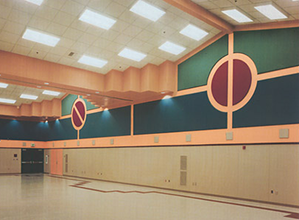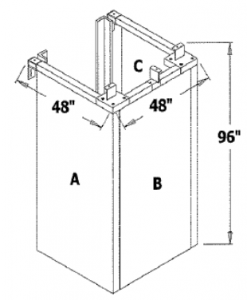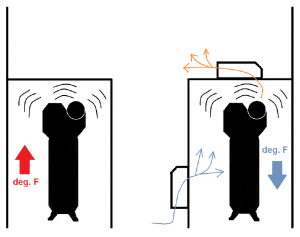Air Compressor Sound Enclosure
eNoise Control has extensive experience solving air compressor noise solutions. Air Compressor Sound Enclosures are probably the most common application we have encountered. There is an air compressor in almost every shop that creates noise each time the motor kicks on, annoying the people that work around it. Below we explain our approach to successfully quieting the air compressor with sound curtains without limiting access and airflow.
The first step is determining the location of the compressor. Typically they are in a corner or against a wall. The least common location of the compressor is in the middle of the room. Next, we need to know how high the ceilings are in that space. Both of these – compressor location and ceiling height – play a factor in the design of the sound curtain enclosure.
In free space, the air compressor radiates sound in all directions and you hear the true sound level. When the air compressor is set next to a wall, in a corner, or in a space with low ceilings, you will hear both the direct sound from the air compressor and the reflected sound coming off the walls and ceiling, making the air compressor’s noise levels even louder.
Unit Location & Number of Sides
This is where experience and good acoustical design can save you trial and error, along with time and money. The sound control concept of Noise – Path – Receiver, where we want to block the path of the noise, or at least make it take an indirect route to the receiver.
In the case of an air compressor sound curtain enclosure, we can define the number of walls and whether or not a top or roof on the enclosure is required.
Unit Location Number of Sides
Corner Two Sided
Against a Wall Three Sided
Middle of Room Four Sided
The rule of thumb is if your non-absorptive ceiling height is less than 15 feet, you may need a top or roof on your sound curtain enclosure. Without a roof, the sound will reflect off the ceiling and the sound reduction performance will be greatly diminished. In spaces with ceilings higher than 15 feet, you have the option of utilizing a sound enclosure with an open top. For an open top sound enclosure (no roof), we recommend a wall height of 48″ above the noise source minimum. Typical sound reduction for an open top sound curtain enclosure is 10-14 dBA reduction.
Air Compressor Enclosure Drawings
Below are several examples of drawings for open top compressor sound curtain enclosures.
Sound Curtain Enclosure Installation
Below is a video of a sound curtain enclosure installation. The enclosure in the video has three sides and is against a wall.
In spaces with a ceiling height of less than 15 feet, we recommend a sound enclosure with a roof, or a noise reduction box. Typical sound reduction for a full sound curtain enclosure is 15-20 dBA. Below are several examples of drawings for compressor sound curtain enclosures with a roof.
You will note that the sound curtain enclosures with a roof have ventilation hoods of baffles for cooling equipment. For air compressor applications, we typically utilize passive ventilation (no forced air fan). The concept is that you locate silenced air intake as low as possible on the side wall and also locate the silenced air discharge on the roof. As the hot air rises and exits out the discharge vent, it draws fresh air through the intake vent.
Each ventilation baffle is rated for approximately 700 cfm of passive airflow. For large equipment with high horsepower motors, forced air ventilation may be required.
Sound Curtain Compressor Sound Enclosures offer many advantages over other sound reduction measures – low cost, accessibility, ease of relocation, flexible design, custom size, high performance. Call eNoise Control at 888.213.4711 for answers to any of your sound curtain enclosure questions.











